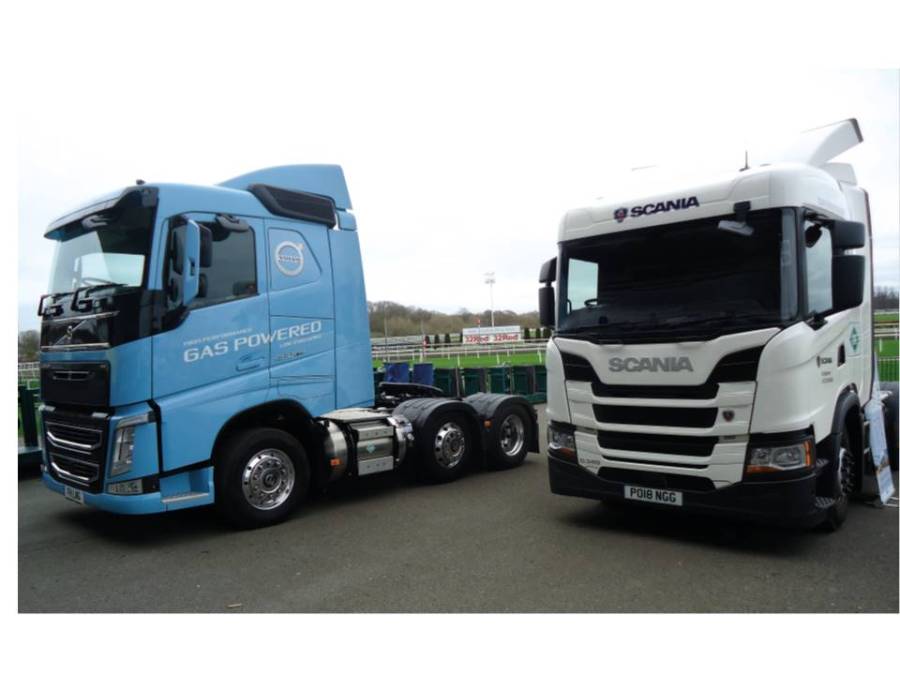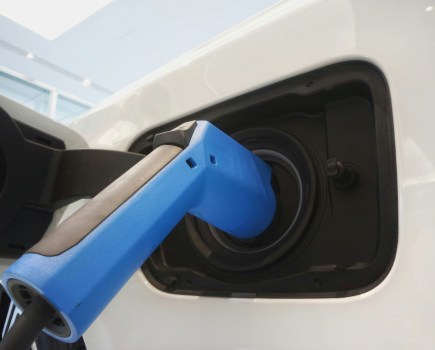The move to ultra-low emissions zones is concentrating minds in the haulage industry, as demonstrated at the recent LoCity Alternative Fuels Conference in Kempton Park
Held only two weeks before the introduction of the London ULEZ, this gathering attracted over 500 delegates.
Of course, low emission zones will not be confined to London: by the end of 2021 at least a dozen major urban areas will be affected.
In short, commercial vehicles prior to Euro 6 will have to pay a fine to enter or traverse them.
This conference brought together alternative fuel specialists enabling fleet managers to consider whether to renew fleets with Euro 6 trucks or evaluate alternatives.
Battery power:More obvious for LGV
It is becoming clear battery power in the medium term may be viable for many urban operators, although such operators will clearly need to give as much consideration to how they will recharge them as to the vehicles themselves.
This could for example mean having to relocate the company to an area where high-voltage electrical supply is available.
While electricity may be an LGV solution, it is rather less applicable to HGV. A majority of OEMs have now announced battery-driven models – mostly 6×2 rigids and some 4×2 tractors – and trials are being run with some firms on the Continent.
In each case relatively short distances are involved, as is a dedicated charging arrangement.
Indications are the purchase price of a 26-tonne battery rigid could be up to four times its diesel equivalent (and the leasing cost commensurately high), so for the foreseeable future these can only be regarded as niche market vehicles.

James Westcott of refuelling
infrastructure specialist Gasrec
confirmed that the
breakeven figure for a gas truck was
130,000 km/pa
Gas fuels: An HGV alternative
Burning natural gas in truck engines has come a long way since the leaky dual-fuel vehicles of 15 years ago.
Retailer John Lewis has been pioneering gas for some years in its Waitrose fleet (as detailed in the previous issue Trucking) and now has 60 tractors running on CNG (compressed natural gas).
It aims to have an entire gas fleet within a decade. The operator is effectively now the benchmark for out-and-back fleets.
Speaking to delegates at Kempton, Mick Doe of Clipper Logistics described how this mixed-fleet operator has plumped for LNG (liquified natural gas) for its trunking division.
“Clipper was doing 45 million km/pa on diesel and to move away from diesel for our artic fleet, we opted for LNG.
“The trucks cost more to lease, but if you do more than 130,000 km a year, this soon evens out and then you save on fuel costs, which are 30 per cent lower.
“We have smaller fuel tanks because we have a specially lowered kingpin which enables us to load 60 pallets, and even then we still have a range of 1100 km compared with 750 km with diesel.
We appreciate a non-standard truck will have a reduced residual value, but this is nothing against the fuel savings.”
However, Mick Doe had advice to pass on: “The biggest drawback is infrastructure. There is very little LNG in the South East. Northern England has better coverage, but we have had to replan some trunking routes to pass service stations. As it stands, LNG won’t work for tramping.
“For tractors, we chose Iveco and the relationship has worked well – we’ll have ordered 17 CNG 6×2 tractors for one contract and nine LNG rigids.
“To make this work we have found you need to have partnerships with suppliers, as we do with Iveco and also with Tevva.
“We are trialling an electric Tevva 14-tonner for urban work. That’s learning curve for our drivers as they need to adapt their driving to suit regenerative braking, but it improves their driving by making them think.”
James Westcott from gas refuelling infrastructure specialist Gasrec confirmed the 130,000 km/pa breakeven point for gas trucks, which retail approximate 25 per cent above the equivalent diesel specification.
He also confirmed the government is committed to maintaining the duty differential of 30 per cent “at least until 2022”.
Again, the theme of partnerships to promote gas use was apparent.
He explained opening a gas filling station could take could take 18 months to complete installation, “and that was from planning permission, which might be more readily obtained if a local business was involved”.
He cited Ocado which, with Gasrec’s help, built its own LNG site in Hatfield.
“Initially it has capacity for 29 fills/per day, but Ocado will extend this and open the station to local hauliers who could use it to experiment with the practicalities of gas trucks, but which don’t have ready access to pumps, a way of introducing gas to the local haulage community.”
Privately owned Gloucestershire haulier Howard Tenens has one of the longest records in gas traction. Its commercial director, Matt Davis, explained how they had begun with dual fuel in 2008.
“Most of our work is either end of the M4, so we invested in our own grid-connected station at Swindon. This has been vital to the operation.
“In 2017 we decide to eliminate diesel altogether by getting rid of dual fuel. This was something of an act of faith, though we did have 10 years’ experience.
“We chose CNG because the tanks need no venting and we had the filling facility at Swindon. The business case for a truck costing £22,000 more retail (or 25 per cent more in lease costs) was CNG costing 40 per cent less than diesel, which meant the truck had paid for itself in three years.
“And with customer contracts of 3-5 years, we could commit.”
Tenens is double-shifting two CNG Scanias between Honda in Swindon and London and South Wales, with back-to-base refuelling.
A comparator diesel Scania is also running and, using telematics, the entire trial is being overseen by Senex – which will report in September.
“Our technicians have had no trouble with maintenance and Scania has been instrumental in training drivers and overcoming range anxiety.
“The drivers are very positive about the CNG vehicles – they feel no difference in torque, but we recognise we are dependent on our filling site to keep operations running.
“The experience so far is diesel reliability with none of the leaks of dual-fuel, and we are now buying bio-CNG which reduces our carbon footprint by 75 per cent.”

The Volvo’s fuel system installation had a definite ‘production’ rather than ‘aftermarket’ look
Gas refrigeration
Dermott Crombie, formerly with Thermo King, pointed out one in six deliveries in London involved refrigeration, and the just-in time distribution model modern society works to means food supply at any one time is only 48 hours.
Hitherto, refrigeration has been run from a separate diesel unit or from the truck engine – but with the increasing exclusion of diesel in urban areas, alternatives were needed.
Batteries, he said, were far too expensive, and infrastructure to recharge commercial fleets did not exist: “It takes 32 hours to charge a Tesla on a domestic power point!” he explained.
New refrigeration systems, already in use on the Continent, use liquid CO2.
These are no-emission and noiseless, and open the way for overnight urban drops which many authorities have previously banned.
Alternative fuel infrastructures
These are really at a very early stage. There are certain niche operations, for example Reading Buses, which use CNG.
But in general availability of gas varies around the UK, and the experts’ advice is any venture into non-diesel needs long-term planning and the kind of third-party involvement described by Howard Tenens, Ocado and Clipper.
The John Lewis experience is perhaps the best example to date. Significantly it has built its gas operation around defined routes and fuelling facilities.
To HGV operators concerned about fleet renewal given diesel uncertainties, yet lack of properly distributed alternative fuels, the experts’ view was that for the next buying cycle, fleet engineers could
continue to specify diesel – Euro 6 Step D means they can be confident for the next five years.
Retrofitting: Declining relevance
Colin Smith from the Freight & Clean Vehicle Retrofit Accreditation Trust looked at the options for HGV.
Basically, operators had to weigh the cost of retrofitting against replacement of Euro 5 with new or secondhand Euro 6 trucks.
He pointed out neither FTA nor RHA recognises retrofitting, and neither is demand pushing the market. Large numbers of buses have been successfully retrofitted, but relatively few trucks – and most of these are refuse vehicles which, ironically, have a particularly demanding use cycle.
Mark Cooper from German retrofit specialist HJS stressed the importance of specifying certified equipment.
A retro system is essentially an SCR which has to function independently without modification of the truck’s CANbus.
Installing an HJS system, he said, was straightforward and, besides the SCR itself, involved fitment of an AdBlue tank and a service display feature and control unit in the cab. Telematics monitor the functioning of the SCR.
Cooper said the London ULEZ had already generated a lot of interest, particularly in the LGV sector. By the time the ULEZs are national, Euro 5 trucks will be at least eight years old, so hauliers outside London may well decide fleet renewal is more appropriate.
For trucks with special bodies or equipment – for example cranes or wreckers – which normally have far longer lives, retrofitting an SCR does appear a cost-effective option.






